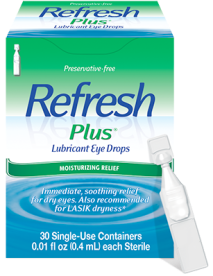![]()
BAC and your health
An eye examination or the use of artificial tears should not end in a condition worse than before the supposed protective activity. But many times this is just the case. Eye drops – regardless of their chemical makeup – contain preservatives to keep them free of bacteria. These preservatives can and do cause many people a great deal of suffering. The good news is, this suffering is avoidable.
If you are a sufferer of Chemical Sensitivity, then this post will be much more than simply, an article ‘of interest’ to you. The information here will spare you some serious suffering; some of it potentially life-threatening.
As I write this article, my right eye is puffy, red, irritated, itchy, watering and inflamed. I had an eye exam 3 days ago, in which my regular ophthalmologist used an examination eye drop containing one of the most common preservatives used: BAC.
BAC is a widely used chemical preservative. BAC is used in a wide range of commonly used products, such as soaps, cosmetics, cleaning products, ophthalmic preparations, disinfectants, and spermicides. BAC inhibits bacterial and fungal growth. Thereby rendering the solutions, in which BAC is found, safe from bacteria-borne infections. A very useful commodity for sure.
However, most such solutions (read: ALL!) come with a price. BAC is NOT an exception to this rule.
With BAC, that price is paid in your health.
Yes, the very premise upon which it is intended to protect; at least in the publicized intent of the manufacturers of the products in which it is found. But in reality, BAC is more dangerous than most of the chance infections it is intended to prevent.
BAC is one of four (4) acronyms used for Benzalkonium Chloride [1]. BAC is a highly hydrosoluble bipolar compound with surfactant properties; which means it acts like a detergent. When BAC is in concentration between 0.004 and 0.02%, topical products (liquid products) do NOT allow bacterial cell walls or membrane to attach to any part of the products cellular structure. BAC’s use is focused on stopping what is called, Gram-positive bacteria; those who are known to be serious causative agents of infection.
Simply put, BAC makes the liquid environment ‘too slick’ for bacteria to colonize. If bacteria cannot colonize, they die. With no bacteria in the solution, then the solution drops to an industry standard level of ‘unlikely infection potential’. That is, for manufacturers and medical professionals, a sought-after acceptability. Products then can be promoted, sold and used, on humans, for an often broad-spectrum of needs, by the millions of units.
Underneath all this euphemistic jargon, it simply means the product will become profitable. Those who make it can make money; usually a lot of money; from it. Score. Point. Game.
For the most part, this kind of logic is also based upon a reasonably scientific rationalization. A product that ‘stops or interrupts’ infection is a good thing; especially in the medical professions. So why would this not be a good thing? Well, it is, in concept, for the most part.
For the most part. That is until you look into what Benzalkonium Chloride does to the cells of the human body. Then the value of its use comes into serious question.
Animal studies have shown that BAC has toxic effects, even in a single dose, at low concentrations, on the corneo-conjunctival surface (cornea: clear covering over the iris; conjunctiva: the clear mucous covering of the eyeball).
It has been long known to ophthalmological professionals, that BAC, during prolonged usage in topical drugs, that damage will occur and the rise in allergic response is exhibited.
I address BAC (Benzalkonium Chloride) here because it is the most popular preservative used in topic pharmacology for the eyes. But as this one study [2] clearly shows, ALL preservatives have either a toxic or allergic danger (or both) in their use; especially prolonged use. Or to quote them:
“…study confirms that most preservatives used in ophthalmic eye-drops may similarly induce strong histopathological and inflammatory changes in the ocular surface after short-term use.”
Alright. I have addressed the problem. I said there was a path to avoid this suffering. And so there is.
Preservative Free Eye Drops
UPDATE: My eye doctor suggested I use the Refresh PLUS artificial tear because it is ‘preservative free’. And it may be – BUT – it is not free of chemicals harmful to hypersensitive people. Thus I cannot recommend any OTC or prescription eye drops either. What my MCS facilitator told me today – when I went in to be cleared of the chemicals that caused the MCS FRAGG event, was to use highly diluted baby shampoo to wash your eyes. People who are hypersensitive to chemicals should NOT use Refresh PLUS or any kind of eye drop. Even though the package and product are marketed as ‘Preservative Free’, it still contains far too many chemicals that would be detrimental to the hyper-sensitive.

Refresh Plus Eye Drops – the only Preservative-free eye drops I can honestly recommend because I have used them without negative incident. – YOS
Never assume a medication is OK. You do not know until you try it. And that could be a very painful – possibly destructive – experience. In this case: “The more you know the better off you will be.”
– YOSAKIME
References
[1] Benzalkonium chloride – https://en.wikipedia.org/wiki/Benzalkonium_chloride
[2] Histopathological effects of topical ophthalmic preservatives on rat corneo-conjunctival surface – https://www.ncbi.nlm.nih.gov/pubmed/9561834
[3] Refresh Plus (corporate info) – http://www.refreshbrand.com/Products/refresh-plus
[4] What is: Carboxymethylcellulose sodium – http://www.webmd.com/drugs/2/drug-18521/carboxymethylcellulose-sodium-ophthalmic/details
[5] Drugs.com on preservatives in eye-drops – https://www.drugs.com/otc/108027/refresh-plus.html










